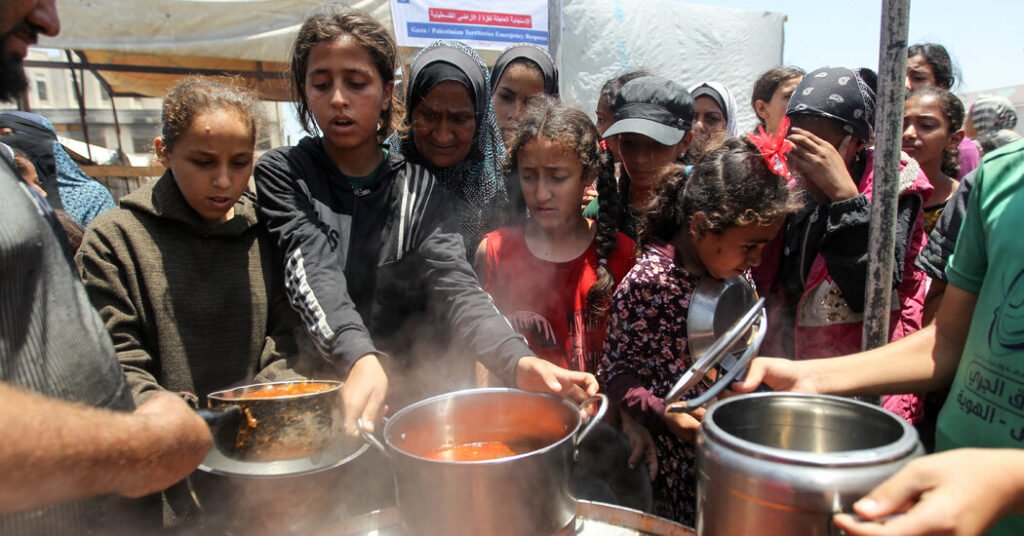The Gaza Strip is at high risk of famine, with some half a million people facing starvation due to catastrophic food shortages, a group of global experts said on Tuesday, but stopped short of saying that the famine in the Strip had begun as a result of Israel’s war against Hamas.
Experts said the amount of food arriving in northern Gaza has increased in recent months, and Israel, under intense pressure from governments and aid groups around the world, recently opened a border crossing for aid in the north.
The analysis by this group: Comprehensive Food Security CategorizationThe International Fund for Hunger Relief (IPC) wields considerable influence: the group is a partnership between UN agencies and major relief organizations, and world leaders rely on it to gauge the severity of hunger crises and allocate humanitarian aid.
After Hamas launched deadly attacks against Israel on October 7, Israeli authorities declared a siege on Gaza and severely restricted the flow of humanitarian aid, citing their unwillingness to help Hamas. Between October and early May, the daily number of aid trucks entering the Gaza Strip through two main southern crossing points fell by about 75%, according to UN data, leading to widespread reports of hunger and malnutrition.
Israeli officials have insisted for months that there are no limits on the amount of food and other aid entering the Gaza Strip. In recent weeks, Israel has increased the number of commercial vehicles transporting food and other supplies across the border.
The report said nearly all of Gaza’s roughly 2.2 million people face severe food insecurity, putting the Strip at “emergency” level, or Phase 4, on a five-level classification scale. But 495,000 people face “catastrophic levels of acute food insecurity,” which would be Phase 5 on the scale.
“At this stage, households experience extreme food insecurity, hunger and depleted coping capacities,” the report said.
In March, the IPC predicted famine was likely in northern Gaza by the end of May. But on Tuesday, the organization announced an increase in the amount of food and other nutritional supplies delivered to the area in March and April.
The increase “appears to have temporarily alleviated the situation” in the north, the report said, adding that “available evidence does not indicate that famine is currently occurring in this situation.”
In early May, Israeli forces sent ground troops to the southern Gaza city of Rafah, forcing more than one million people, many of whom had been previously displaced, to flee to highly vulnerable coastal areas lacking basic infrastructure.
The military operation led to the closure of the Rafah border with Egypt and the suspension of aid deliveries at the Kerem Shalom border with Israel, and the situation in the south has since worsened, the report said.
To buy food, more than half of Gaza’s households “have had to exchange their clothes for cash and a third have had to pick up trash and sell it,” the IPC said, adding that more than half of households often have nothing to eat, with more than 20 percent going entire days and nights without food.
The IPC considers a region to be in famine when more than 20 percent of households face extreme food insecurity, more than 30 percent of children are acutely malnourished, and at least two adults or four children per 10,000 people die each day from hunger or malnutrition-related diseases. Since the IPC was established in 2004, its methodology has been used in only two famines: in Somalia in 2011 and South Sudan in 2017.
After the group warned of imminent risk of famine in Gaza in March, South Africa asked the UN’s highest court, the International Court of Justice, to issue an emergency order to Israel to stop the “genocidal starvation” of Palestinians. The request is part of a broader lawsuit in which South Africa accuses Israel of genocide in Gaza, a charge Israel denies.
The Hague-based court ordered Israel to “immediately” stop military attacks in Rafah a month ago, stressing the need to open land checkpoints as part of a call for the “unhindered delivery” of humanitarian aid. The order increased global pressure on Israel to scale back attacks and limit civilian casualties, even as attacks in Rafah continue.
Israeli officials acknowledge there is famine in the Gaza Strip but accuse Hamas of stealing and misappropriating aid. Ismael Tawabteh, deputy head of Hamas’ government media office in the Gaza Strip, said last month that the allegations are “completely false and inaccurate.” He added that while there has been looting of aid, it has been perpetrated by a small minority of people driven to desperation by Israel.
Some Gaza residents accuse Hamas of profiting from looted aid.

